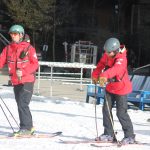Top 5 most-read stories last week: Snowstorms, Frisco home sale and chairlift fall

Katie Girtman/Studio Kiva Photography
Stories in this list received the most page views on SummitDaily.com from Nov. 9-12.
1. Meteorologists see 3 snowstorms ahead of Thanksgiving, will it be enough to reverse Colorado’s dry start to the season?
Colorado’s unusually dry fall could be coming to an end, as forecasters predict a wave of snowstorms to start this weekend and continue until about Thanksgiving.
Meteorologist Seth Linden — who runs Seth’s Weather Report, a popular Facebook page that provides mountain forecasts — said that the incoming snow will be welcomed by the state’s mountain towns, where the local economies rely on snow to drive tourism.
“Summit County, Eagle County, Grand County, the Central Rockies — communities depend on good snow for advertising,” Linden said. “It draws people in. Good snow, a good base and a good snow pack brings people in. That’s the opposite of what it is right now.”
— Ryan Spencer, Nov. 13
2. This Frisco home sale is the most expensive on record in the town’s history
Frisco just saw its most expensive home sale on record coming in at over $6.5 million for a single-family in the Frisco Heights subdivision.
The Summit County Assessor’s Office said the data it has indicates the sale that occurred on Monday, Oct. 20 is the highest priced single-family residence on record, and the Altitude Realtors Association confirmed this through Multiple Listing Service data.
The approximate 6,135-square-foot home with six bedrooms and six bathrooms is located at 152 County Road 1040 and sits on a 1.17-acre lot. Selling real estate agent Derrick Fowler, owner of Colorado Mountain Homes Real Estate, said the home’s amenities and its near-perfect condition is what made it stand out to him.
He said unique amenities in the property included elm flooring from a Tibetan monastery and a horse-shoe, or “rough neck,” shaped bar. Additionally, because one of the home’s prior owners was a professional skier, he said there’s a sizable workout room alongside a media/game room. There’s also a butler’s pantry, a turret-level office and a second-floor wet bar. The home came fully furnished with art and decor.
The home was built in 2011, but Fowler said it would be difficult to know it was built 1.5 decades ago given its current condition.
— Kit Geary, Nov. 11
3. Fall from chairlift at Keystone Resort results in no life-threatening injuries, according to Sheriff’s Office
A snowboarder suffered injuries after falling from the Montezuma Express chairlift at Keystone Resort on Thursday, Nov. 13, according to the resort.
Sarah McClear, the communications manager for Keystone Resort, wrote in an email that a 27-year-old male snowboarder fell off the Montezuma Express chairlift Nov. 13. Keystone Ski Patrol responded to the incident, and the man was transported to the Keystone Medical Center facility, McClear wrote.
— Kyle McCabe, Nov. 13
4. With bridges starting to go up, drivers on I-70 will see ‘magnitude and size’ of $900 million Floyd Hill Project
The Colorado Department of Transportation is moving mountains — literally — as part of a $900 million project to rebuild an 8-mile section of Interstate 70 to improve safety and travel time reliability.
Since October last year, crews working on the Floyd Hill Project have completed more than 135 rock blasts, removing more than 600,000 tons of material, an amount equal to the weight of 20 Statues of Liberty, according to the transportation department.
Now, work has begun to build new interstate bridges with gentler, safer curves through the widened canyon that is a main thoroughfare for those traveling between Denver and the mountains.
“Over the next four to six months, people are going to start to see where the new alignment is going to go,” said Matt Hogan, the project manager for Kraemer North America, the general contractor on the Floyd Hill Project. “They’re going to start to realize the magnitude and the size of the project, and hopefully really start to envision the future of what driving on this mountain corridor is going to be.”
— Ryan Spencer, Nov. 14
5. Why the lack of early-season snow has Colorado backcountry experts cautiously optimistic about a ‘silver lining for snow lovers’
Snowfall in Colorado has been lackluster to start the ski season, but for backcountry enthusiasts the lack of early-season snow has the potential to lead to safer avalanche conditions down the road.
When snow falls in October or early November, it often forms a weak layer in the snowpack that can become dangerous when it gets buried later in the season, Colorado Avalanche Information Center Director Ethan Greene said Monday. So far this season, there hasn’t been enough snow to create that potential weak layer.
“Of course, there’s a lot of other perspectives around snow in the mountains,” Greene said, “but the best thing from an avalanche perspective is we want it to not snow and then, when it starts snowing, to snow continuously enough to develop a thick and strong snowpack.”
The CAIC kicked off its daily avalanche forecasts at the start of November, but to date there has been little to no risk of avalanches due to the lack of snow. The avalanche forecasts, which rate avalanche danger on a scale from low to extreme, are posted to Colorado.gov/avalanche around 4:30 p.m. each afternoon for the following day.
While a handful of ski resorts in Colorado are already open thanks to snowmaking, the state’s snowpack was just 21% of median on Tuesday, and only small amounts of snow remain in the backcountry.
— Ryan Spencer, Nov. 11

Support Local Journalism

Support Local Journalism
As a Summit Daily News reader, you make our work possible.
Summit Daily is embarking on a multiyear project to digitize its archives going back to 1989 and make them available to the public in partnership with the Colorado Historic Newspapers Collection. The full project is expected to cost about $165,000. All donations made in 2023 will go directly toward this project.
Every contribution, no matter the size, will make a difference.










